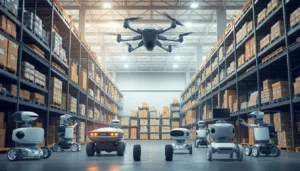In a world where coffee breaks and manual data entry seem to go hand in hand, Robotics Process Automation (RPA) swoops in like a superhero in a cape—minus the spandex. Imagine a workplace where tedious tasks vanish faster than a magician’s rabbit, leaving employees free to focus on what really matters. RPA isn’t just a buzzword; it’s the secret sauce that transforms mundane processes into streamlined efficiency.
Table of Contents
ToggleUnderstanding Robotics Process Automation
Robotics Process Automation (RPA) transforms workplace efficiency by automating repetitive tasks. This encourages employees to focus on higher-value activities.
Definition and Overview
RPA refers to the use of software robots to complete tasks traditionally performed by humans. These robots interact with applications just like a human would, executing tasks such as data entry and report generation. Organizations implement RPA to streamline workflows, reduce errors, and cut operational costs. By enabling automation, companies can improve productivity significantly while enhancing the accuracy of data handling and processing.
Key Components of RPA
Several critical components define effective RPA implementations. Software robots serve as the primary execution agents that automate processes. A control center enables monitoring and management of these robots, ensuring optimal performance. Additionally, integration tools allow RPA solutions to connect seamlessly with existing systems and applications. Analytics features provide insights into process efficiency and highlight areas for further automation. Each of these components plays a vital role in creating a robust and efficient RPA ecosystem.
Benefits of Robotics Process Automation
Robotics Process Automation (RPA) offers significant advantages that transform workplace efficiency and operational costs.
Increased Efficiency
RPA dramatically boosts productivity by allowing software robots to complete tasks at high speeds. Employees can then focus on strategic initiatives rather than routine data entry. Working around the clock is another advantage; RPA systems can execute processes 24/7 without breaks or downtime. The consistency of outputs also improves as RPA reduces human error in repetitive tasks. In short, integrating RPA leads to faster cycle times and quicker response rates across various workflows.
Cost Reduction
RPA significantly decreases operational expenses through automation. By reducing the need for manual labor, organizations can lower staffing costs and reallocating resources to more critical functions. Implementing RPA technologies often results in decreased error rates, leading to fewer costly mistakes. Moreover, companies typically notice reduced training costs since software robots operate through pre-defined scripts. Ultimately, the initial investment in RPA technology translates into long-term savings, enhancing the overall financial health of an organization.
Challenges in Implementing RPA
Implementing Robotics Process Automation (RPA) can pose several challenges that organizations must address for successful adoption.
Technical Limitations
Technical limitations often hinder RPA implementations. Organizations might face difficulties with existing legacy systems that lack integration capabilities. Compatibility issues arise, making it challenging for software robots to communicate effectively with current applications. Performance can deteriorate if the infrastructure isn’t robust enough to handle RPA operations. Additionally, the complexity of processes can lead to incomplete automation if not properly assessed. Ensuring proper technical capabilities is crucial for maximizing RPA’s benefits.
Change Management
Change management plays a vital role in the RPA implementation process. Resistance from employees often arises due to fear of job displacement or the unfamiliarity of new technology. Effective communication strategies are necessary to alleviate concerns and promote understanding. Organizations must foster a culture of adaptability, emphasizing that RPA enhances human capabilities rather than replacing them. Training programs should provide employees with the skills necessary to work alongside software robots. Managing this transition positively influences the success of an RPA initiative.
Future Trends in Robotics Process Automation
Robotics Process Automation continues to evolve, impacting various sectors significantly. Anticipated advancements promise to further streamline operations, enhancing organizational efficiency and effectiveness.
AI and Machine Learning Integration
AI integration transforms RPA by improving decision-making processes. By incorporating machine learning, RPA systems analyze data patterns, enabling them to predict outcomes and adapt to changes autonomously. This capability enhances task accuracy and efficiency. Companies experience increased automation effectiveness as systems learn from historical data. RPA evolves into a more intelligent solution rather than just a tool for repetitive tasks. This shift allows organizations to leverage advanced analytics in real-time, driving better insights and fostering informed decision-making.
Industry-Specific Applications
Industries increasingly adopt RPA tailored to their unique needs. Financial services utilize RPA for automating compliance checks and fraud detection, significantly reducing processing times. Healthcare providers enhance patient data management and billing accuracy through RPA, ensuring timely reimbursements. Retail operations streamline inventory management and order fulfillment, improving customer satisfaction. Manufacturing sectors implement RPA for quality control and supply chain optimization, cutting costs and minimizing errors. Each industry benefits from dedicated RPA solutions, driving progress and innovation in its processes.
Robotics Process Automation is reshaping the way organizations operate by freeing employees from repetitive tasks. By embracing RPA, companies can unlock new levels of efficiency and productivity. The integration of AI and machine learning into RPA systems promises even greater advancements, allowing for smarter decision-making and enhanced data analysis.
As industries continue to adopt RPA solutions, the potential for innovation and growth becomes limitless. Organizations that effectively manage the challenges of implementation will find themselves at the forefront of this technological revolution. Embracing RPA not only streamlines operations but also empowers employees to focus on strategic initiatives, paving the way for a more dynamic and competitive future.










